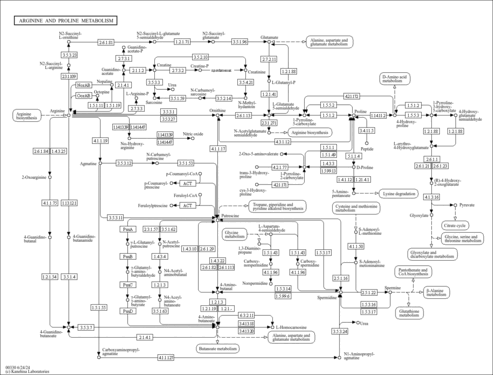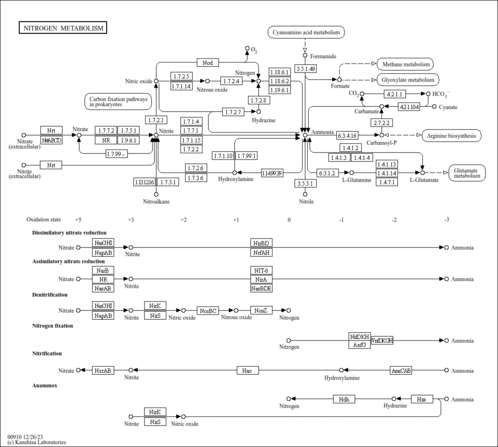| Identification |
|---|
| YMDB ID | YMDB00982 |
|---|
| Name | no |
|---|
| Species | Saccharomyces cerevisiae |
|---|
| Strain | Baker's yeast |
|---|
| Description | Nitric oxide, also known as NO or EDRF, belongs to the class of inorganic compounds known as other non-metal oxides. These are inorganic compounds containing an oxygen atom of an oxidation state of -2, in which the heaviest atom bonded to the oxygen belongs to the class of 'other non-metals'. Nitric oxide is an extremely weak basic (essentially neutral) compound (based on its pKa). Nitric oxide exists in all living species, ranging from bacteria to humans. |
|---|
| Structure | |
|---|
| Synonyms | - Mononitrogen monoxide
- Nitric oxide
- Nitrogen monoxide
- Nitrogen oxide
- nitrogen protoxide
- Nitrosyl hydride
- Nitrosyl radical
- Nitroxide radical
- Nitroxyl
- (NO)(.)
- [NO]
- EDRF
- Endothelium-derived relaxing factor
- Monoxido de nitrogeno
- Monoxyde d'azote
- Nitrogen monooxide
- Nitrosyl
- NO
- (.)NO
- NO(.)
- Oxido de nitrogeno(II)
- Oxido nitrico
- Oxyde azotique
- Oxyde nitrique
- Stickstoff(II)-oxid
- Stickstoffmonoxid
- INOmax
- Endogenous nitrate vasodilator
- Monoxide, nitrogen
- Nitric oxide, endothelium derived
- Nitric oxide, endothelium-derived
- Monoxide, mononitrogen
- Vasodilator, endogenous nitrate
- Endothelium-derived nitric oxide
- Nitrate vasodilator, endogenous
- Oxide, nitric
|
|---|
| CAS number | 10102-43-9 |
|---|
| Weight | Average: 30.0061
Monoisotopic: 29.997988627 |
|---|
| InChI Key | MWUXSHHQAYIFBG-UHFFFAOYSA-N |
|---|
| InChI | InChI=1S/NO/c1-2 |
|---|
| IUPAC Name | nitroso |
|---|
| Traditional IUPAC Name | nitric oxide |
|---|
| Chemical Formula | NO |
|---|
| SMILES | N#[O] |
|---|
| Chemical Taxonomy |
|---|
| Description | belongs to the class of inorganic compounds known as other non-metal oxides. These are inorganic compounds containing an oxygen atom of an oxidation state of -2, in which the heaviest atom bonded to the oxygen belongs to the class of 'other non-metals'. |
|---|
| Kingdom | Inorganic compounds |
|---|
| Super Class | Homogeneous non-metal compounds |
|---|
| Class | Other non-metal organides |
|---|
| Sub Class | Other non-metal oxides |
|---|
| Direct Parent | Other non-metal oxides |
|---|
| Alternative Parents | |
|---|
| Substituents | - Other non-metal oxide
- Inorganic oxide
|
|---|
| Molecular Framework | Not Available |
|---|
| External Descriptors | |
|---|
| Physical Properties |
|---|
| State | Gas |
|---|
| Charge | 0 |
|---|
| Melting point | -163.6 °C |
|---|
| Experimental Properties | | Property | Value | Reference |
|---|
| Water Solubility | Not Available | PhysProp | | LogP | Not Available | PhysProp |
|
|---|
| Predicted Properties | |
|---|
| Biological Properties |
|---|
| Cellular Locations | Not Available |
|---|
| Organoleptic Properties | Not Available |
|---|
| SMPDB Pathways | |
|---|
| KEGG Pathways | |
|---|
| SMPDB Reactions | Not Available |
|---|
| KEGG Reactions | Not Available |
|---|
| Concentrations |
|---|
| Intracellular Concentrations | Not Available |
|---|
| Extracellular Concentrations | Not Available |
|---|
| Spectra |
|---|
| Spectra | | Spectrum Type | Description | Splash Key | View |
|---|
| Predicted GC-MS | Predicted GC-MS Spectrum - GC-MS (Non-derivatized) - 70eV, Positive | splash10-001i-9000000000-d182bfca83d886821e6d | JSpectraViewer | | Predicted GC-MS | Predicted GC-MS Spectrum - GC-MS (Non-derivatized) - 70eV, Positive | Not Available | JSpectraViewer | | Predicted LC-MS/MS | Predicted LC-MS/MS Spectrum - 10V, Positive | splash10-001i-9000000000-8a2dd9da1fc114d013b3 | JSpectraViewer | | Predicted LC-MS/MS | Predicted LC-MS/MS Spectrum - 20V, Positive | splash10-001i-9000000000-8a2dd9da1fc114d013b3 | JSpectraViewer | | Predicted LC-MS/MS | Predicted LC-MS/MS Spectrum - 40V, Positive | splash10-001i-9000000000-8a2dd9da1fc114d013b3 | JSpectraViewer | | Predicted LC-MS/MS | Predicted LC-MS/MS Spectrum - 10V, Negative | splash10-004i-9000000000-e998110984a05853a05d | JSpectraViewer | | Predicted LC-MS/MS | Predicted LC-MS/MS Spectrum - 20V, Negative | splash10-004i-9000000000-e998110984a05853a05d | JSpectraViewer | | Predicted LC-MS/MS | Predicted LC-MS/MS Spectrum - 40V, Negative | splash10-004i-9000000000-e998110984a05853a05d | JSpectraViewer | | Predicted LC-MS/MS | Predicted LC-MS/MS Spectrum - 10V, Positive | splash10-001i-9000000000-4faa0e3c79683567bab0 | JSpectraViewer | | Predicted LC-MS/MS | Predicted LC-MS/MS Spectrum - 20V, Positive | splash10-001i-9000000000-4faa0e3c79683567bab0 | JSpectraViewer | | Predicted LC-MS/MS | Predicted LC-MS/MS Spectrum - 40V, Positive | splash10-001i-9000000000-4faa0e3c79683567bab0 | JSpectraViewer |
|
|---|
| References |
|---|
| References: | - UniProt Consortium (2011). "Ongoing and future developments at the Universal Protein Resource." Nucleic Acids Res 39:D214-D219.21051339
- Gardner, P. R. (2005). "Nitric oxide dioxygenase function and mechanism of flavohemoglobin, hemoglobin, myoglobin and their associated reductases." J Inorg Biochem 99:247-266.15598505
|
|---|
| Synthesis Reference: | Morabito, Paul; Heicklen, Julian. Disproportionation to combination ratios of alkoxy radicals with nitric oxide. Journal of Physical Chemistry (1985), 89(13), 2914-16. |
|---|
| External Links: | |
|---|


